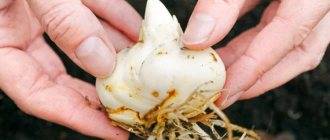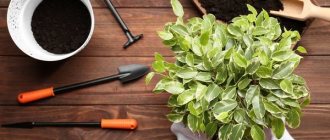Why is it better to wait for a period of rest?
It is better to replant the plant after flowering, when the dormant period begins, so as not to harm this magnificent plant. An orchid should be replanted no more than once every 2-3 years. It is worth understanding that replanting causes stress to any plant, and even more so to a delicate orchid.
The best time to replant the plant after flowering is spring. At this time of year, nature begins to wake up, and it will be easier for the orchid to grow new roots and recover from stress.
As for the children, it is better to plant them in late autumn or winter.
The timing of replanting directly depends on whether the orchid belongs to a particular variety - but spring is the optimal time of year for almost everyone. For example, there are plant species such as cattleya, oncidium and dendrobium that need to be replanted only when the first cuttings appear, but before the baby takes root. And monopodial orchids are replanted as soon as the tips of the roots turn bright green. We talked about the possibility of replanting an orchid in the fall here.
There are many reasons for untimely transplantation of an orchid after flowering, but nevertheless, when making such a decision, you need to think carefully.
Capacities
For an epiphytic or lithophytic exotic pet, it is extremely important to create the best conditions for the root system. Therefore, special attention should be paid to the container in which the orchid will live.
Opaque or ceramic pot
The roots of most species are photosynthetic, which means they need good lighting . In addition, this most vulnerable part of the orchid needs constant monitoring. Transparent container allows:
- promptly notice symptoms of root rotting and poor soil conditions;
- assess the degree of substrate moisture.
Transparent pots allow you to observe the condition of the root system.
New pottery “breathes” well, does not overheat and maintains humidity levels. However, over time, the internal surfaces become greasy and lose these properties.
But the main danger lies in the rough, porous structure of the material: roots cling to it well and grow, which makes it difficult to separate them during transplantation and therefore threatens serious troubles.
Advice! Experienced gardeners know how to deal with the peculiarities of ceramic and opaque containers; they “feel” the plant. For beginners, it is better to choose traditional orchids - plastic, with smooth walls and transparent.
Glass flowerpot
Transparent glass flowerpots meet the requirements of illumination of the roots and the need for regular monitoring of the substrate. But they can’t cope with aeration.
Pots of orchids can be placed in a spacious glass vessel; Vandas with their long, abundant roots will be especially good in a tall vase.
When can a plant change its soil?
As mentioned earlier, after flowering, the flower is replanted in the spring . But how can a beginner determine that it’s time for an orchid to change the soil? There is a theory that the plant should not be touched for 2 years, and only after that is it ready for replanting. But you shouldn’t trust the standards unconditionally, since they are not the same for different species. There are practical examples by which you can accurately determine the time of transplantation:
- a powerful root system that has become cramped in the old pot;
- a large number of aerial roots are formed;
- the leaves began to become covered with pale green or yellow spots;
- the orchid does not produce a peduncle for more than three months from the moment of the last flowering;
- the volume of green mass is several times greater than the size of the pot.
But there are parameters that force the grower to transplant ahead of time.
Why might it be necessary to transplant into another pot?
An urgent plant transplant may be needed in the following cases:
- rotting of the lower leaves and roots;
- the appearance of pests on the plant;
- depleted and excessively dry substrate;
- pale leaves, stunted growth, exposed roots;
- plant instability.
Attention! Water with a high content of heavy impurities and iron can accelerate the process of rotting of the substrate.
If the plant feels good in the old pot, then there is no need to touch it . But if the roots turn black, mold appears on the rosette, or microorganisms appear, then the flower is in great danger.
Read more about whether the orchid needs to be transplanted into another pot here.
Replanting an orchid after purchase. Signs of need
As a rule, an orchid goes on sale in the flowering phase.
It is transported in a transparent plastic pot, in which it can grow for more than one year without replanting.
It is better to place the transport pot in a decorative orchid pot, translucent or matte. It will fit perfectly into the interior of your home.
Attention! Transplanting a phalaenopsis at the wrong time or during flowering is very stressful for it, can harm the plant and even lead to death. It is important to follow the rules when replanting an orchid.
In some cases, an orchid needs care and replanting after purchase, or adjustment of the substrate:
- The orchid is wobbly and does not stand on its own. The reasons for this may be different: One-sided development of leaves and the exit of the leaf blade outside the pot;
- Strong deviation of the peduncle, causing the pot to turn over;
- Insufficient amount of substrate in the flowerpot.
The orchid wobbles and does not stand on its own - it needs a transplant.
To correct these small defects, you can replant after purchase, or you can use other methods:
- The plant can be placed in a heavy glass pot,
- Strengthen the support for the peduncle,
- Or add soil.
So, replanting a phalaenopsis orchid after purchase: how and when you can:
- The pot was damaged during transportation. In this case, the phalaenopsis can be replanted, but it is better to place the plastic pot in a beautiful orchid pot;
- The orchid was purchased at a sale and was not properly cared for. Rotten roots will be visible through the transparent flowerpot of the phalaenopsis - the first sign of waterlogging. In this case, the plant must be transplanted into a new substrate;
- The soil is of poor quality. The soil in which orchids are usually sold often consists of peat with various additives. It vaguely resembles a standard orchid substrate.
This happens because in industrial cultivation an automatic system is used, which takes into account a number of parameters (pot size, humidity and ambient temperature).
They satisfy the needs of the plant at any time of the year.
During indoor cultivation, excessive moisture content of the substrate creates problems.
This indoor flower needs immediate replanting:
- After purchasing a plant in a pot filled with sphagnum moss, the moss is immediately removed, regardless of whether there will be a transplant or not. The vacated volume is filled with a substrate suitable for phalaenopsis;
- If pieces of bark are mixed with peat, the plant must be replanted. Peat is a very moisture-intensive substrate, which can ultimately lead to waterlogging of the roots.
The roots in the peat substrate are waterlogged and rot.
Timely and correct replanting of an orchid will allow you to preserve the plant, which will delight you for many years.
Which rooting method should I choose?
There are two common ways to plant an orchid: on driftwood or in a flowerpot. The method of transplantation in this case is chosen based on your conditions, but sometimes it is dictated by the type of orchid.
On a snag
This is a fairly common way to plant an orchid. Instead of driftwood, you can use a piece of pine bark , only fresh and without resinous secretions. In addition, you can use:
- cork oak;
- tree fern.
The size of the driftwood is chosen based on the type and growth characteristics of the orchid . There are some plants in which shoots form at a great distance, and they can very quickly spread around a small beam. Therefore, in order not to further injure the plant, take care of a large piece of bark.
A peculiarity of this type of planting is the fact that after watering the roots dry out quickly, but it is worth noting that in the natural conditions of the tropics this is what happens. After a rainstorm, the roots dry out in a matter of minutes, and the plant receives a large amount of air, while virtually no rotting occurs.
But you should understand that a plant on a snag will have to be placed in an improvised greenhouse so that the roots do not experience a severe lack of moisture. And during the dormant period, the orchid will need to be watered very rarely.
To the substrate
An orchid is an epiphyte, and a flowerpot for it is a support, not a container for the earth.
- Pots made of any material are suitable for planting plants. You just need to take into account that for some types of exotic beauty you need to use transparent pots. You should not use porous clay pots, as they quickly evaporate moisture.
- The flowerpot should be wide, but not high, since the root system is superficial and grows in breadth.
- The dishes should have many holes, not only in the bottom, but also in the walls; this is necessary not only for draining excess liquid, but also for aeration.
- The top of the pot should be wider than the bottom, otherwise it will be very difficult to remove the plant when replanting.
Step-by-step instructions on how to replant an orchid after flowering: To replant the plant, you need to prepare pruning shears, or sharp scissors, and ash to sprinkle the cuts.
Preparing the pot and soil
In order for your exotic beauty to develop well, you need to choose the right flowerpot . There should be holes at the bottom of the pot - stagnation of moisture has a very detrimental effect on the plant. The pot should be slightly larger than the previous one, but not by excess - there are reasons for this:
- the orchid will not bloom for a long time, as it will build up green mass;
- Moisture may stagnate at the bottom of the pot.
If you decide to buy a ceramic pot, then you should opt only for the glazed inner surface, otherwise the orchid roots will stick to the walls, and it will not be possible to separate them without damaging them.
The substrate can be bought in a store, or prepared independently at home from bark, moss, peat and charcoal. The process of preparing the soil is very troublesome, especially in urban conditions it is difficult to find high-quality fresh pine bark.
You will find more information about preparing the soil and pot for replanting an orchid in this article.
Trimming and separating babies
If an orchid shoots an arrow and blooms, can it be cut off when replanting, and what should be done with the arrow next?
If there are children on the plant that are ready for transplanting, they must be very carefully removed from the mother plant . Some novice flower growers make a big mistake when they separate the baby from the peduncle - this is strictly prohibited, the shoot will not survive. You only need to separate the peduncle 2 centimeters from the growing point on both sides.
- Cuts must be treated with ash, both on the mother plant and on the baby.
- Then leave the baby for half an hour to dry.
- Carefully place the young plant in the ground; you can use a regular plastic cup as a container.
- After the drainage has been laid at the bottom of the cup, the roots of the cuttings are inserted there - you need to act with extreme caution.
- Distribute the roots over the glass and carefully pour in the substrate.
- It is important that the growing point is level with the edges of the container. The soil cannot be compacted, just tap the edges of the cup several times and it will settle.
- There is no need to water the plant for 2-3 days.
If the baby is a root shoot, then without proper experience it is almost impossible to separate it from the mother, without risk to the latter.
We invite you to watch a visual video about separating a baby from an orchid:
Extracting the plant
Before removing the faded plant from the old pot, the substrate is moistened abundantly. Carefully turn the pot over, holding the orchid near the socket, and tap the walls of the container, trying to remove the roots along with the lump of earth.
If the pot is ceramic, you will have to carefully break it with a hammer. If some fragments are stuck to the roots, there is no need to separate them - plant with them.
Washing roots and drying
Before cleaning the roots from the old substrate, it is worth releasing the root ball into warm water for half an hour . Remove the soil and rinse the roots in running water. After inspection, the orchid is left in the air for 7 hours so that the roots dry. You can find out whether you need to trim the roots when replanting an orchid here.
Placement in a new flowerpot
- lay drainage at the bottom of the pot, one third;
- pour one handful of substrate;
- take a support stick and carefully secure the roots of the plant around it;
- put the roots in the pot;
- fill in the missing substrate, knock on the sides of the flowerpot so that it settles.
First watering
There is no need to water the plant immediately; the first watering is carried out on the 4th day after transplantation.
Nuances of aftercare
A faded orchid is considered weakened. Therefore, after transplantation and flowering, the appearance of the orchid may leave much to be desired. There is no need to sound the alarm. Surely the flower will come to its senses soon. But, in order for this to happen faster, you can help him a little. Buy special fertilizer for orchids in the store and use it according to the instructions.
Mineral fertilizers for orchids contain a complex of substances necessary for the flower. They can help restore a flower after flowering, growing babies and replanting. The main thing during the feeding period is to strictly follow the instructions. Otherwise, you can damage the root system. In this case, the damage caused may be irreparable.
Care after transplantation is almost no different from care before these manipulations. It is necessary to water the orchid according to the schedule. Feed the plant. Provide warmth, peace and daylight.
Problems and difficulties
If you do everything correctly, then there will be no difficulties. If the plant is infected with parasites, it will have to be treated by dipping the roots in a special solution for 15 minutes. Also, during transplantation, rotting of the roots may be detected, which will have to be removed . If after transplantation you place a flower on a windowsill, it may get sick; the light should be diffused.
In our other articles you will learn how to care for an orchid after replanting and whether it is necessary to replant the plant after purchase.
Basic Rules
The procedure will be successful and will not harm the plant if you follow the rules:
- Carefully remove the orchid from the pot.
- Free the root system from the old substrate, removing dry or rotten tips.
- Trim the flower stalk if necessary.
- Place in a container with new soil.
- Complete watering.
Then the plant needs to be placed on the windowsill, shading it for a while.
For detailed step-by-step instructions for transplanting, see here.











